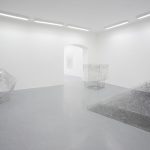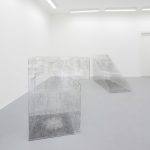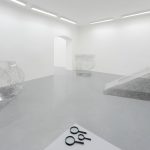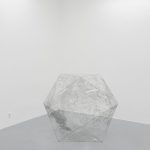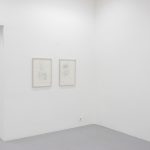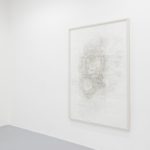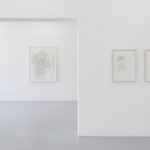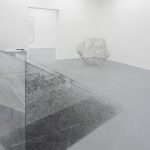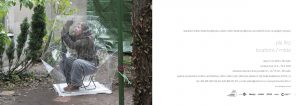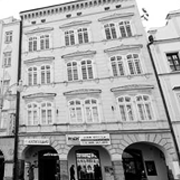Pia Linz – Locations
| Date | – |
|---|---|
| Vernissage | 12.06.2018 18:00 |
| Curator | Michal Škoda |
This summer, the exhibition spaces of the Gallery of Contemporary Art and Architecture / České Budějovice House of Art are reserved for Berlin-based artist Pia Linz.
This is the first exhibition in the Czech Republic for Linz, whose main medium is drawing and who is an absolutely original artist on the contemporary art scene, someone with a highly distinctive style. She typically creates detailed drawings, always working at a particular public space. This decision to create her works away from the “isolation” of the four walls of the studio allows her to spend many hours intimately getting to know a place and the people moving around in “her” territory. On the basis of this subjective use of visual themes and motifs, she produces works that are proof that the way we see the world around us is always a reflection of our individual perception of a fraction of reality.
Pia Linz was born in 1964 in Kronberg, Germany. After completing her secondary education, she studied painting at the Städelschule in Frankfurt am Main under Thomas Bayrle, Johann Georg Geyger, Felix Dröse, and Christa Näher, becoming the latter’s Meisterschülerin. She has been awarded various different grants, which have taken her to cities such as Rome, London, and New York. In 1999, she worked for eleven months at the Schloss Balmoral artists’ residence in Bad Ems as part of a fellowship from the German state of Rheinland-Pfalz. In 2015, she was awarded the HAP-Grieshaber Prize by the VG Bild-Kunst for her work. She currently lives and works in Berlin.
The exhibition in České Budějovice with the evocative title Locations offers a representative overview of works by this outstanding artist. Viewers will find not only drawings on paper, but also objects made of acrylic glass – so-called Box Engravings which Linz creates through the technique of engraving.
Her drawings are not created using just one artistic approach; instead, Linz works with multiple methods representing various cycles. For instance, there are her Drawing Projects associated with a particular place, her Field-of-View Projections, or the aforementioned three-dimensional Box Engravings – the main type of her Projection Works and a continuation of her three-dimensional Cube Pictures.
Speaking of her three-dimensional objects, Linz says, “First, I build an acrylic glass construction in an architectonic or landscape location. At the chosen site I sit inside the construction and capture directly what I see around myself with marker in detailed drawing on the transparent inner walls. At the end I engrave the drawing into the acrylic glass.
In contrast to the panoramas of the 19th century, in which the observer places himself inside the panorama, here the locked-out observer views the miniature world of the box engraving from the outside. In this pictorial reality, the distance, and thereby the rest of the world, is always contained within the object.”
Her Drawing Projects are evidence of her highly sensitive ability to identify with a given location. For instance, when preparing for a project, she measures the selected area (such as when she “mapped” a London park or New York’s Central Park) by counting steps and locating the detailed drawings created in this place within the system she has thus created. These works are accompanied by her observations from that place, which “report” on the natural setting, passers-by, or overhead fragments of conversations.
In view of Linz’s drawing style, viewers feel as if they are looking at the selected location from on high. The images thus resemble a self-contained cosmos. Seen from a distance, we perceive the overall structure; as we move closer and the work’s details become visible, it slowly comes to life and can be deciphered.
We can close our notes on the work of Pia Linz and on this exhibition by quoting her own description of an early series with a specific relationship to place. Writing about her Early Site-Specific Pictures, she says, “While attempting to transfer the experienced reality of time and space into a two-dimensional static picture reality with the Early Site-Specific Pictures during my art studies in the 1980s, I discovered questions and possibilities that still occupy me today. The Early Site-Specific Pictures are therefore the basis and key to my current work.
“My experiences and memories of various standpoints within a place, and the knowledge that the place is not dependent on my subjective perception but exists firmly and simultaneously for itself, are critical to finding the picture’s visual order, as is the positioning of the observer in relation to my pictorial assertion of the place.
“Finally, the Early Site-Specific Pictures closely resemble a map-making way of seeing. At a specific location, for example Frankfurt’s main train station, I collect information that is often infused with subjective experience and poetic notions. This I synchronize into a kind of map, whereby I re-experience the notes and reinterpret them for the specific medium of the picture.
“In so doing, I discover the two-dimensional surface as an omnipotent assertional space that enables me to establish the undefined rest of the world between the focused place and the edge of the picture.”
Wrote about the exhibition

